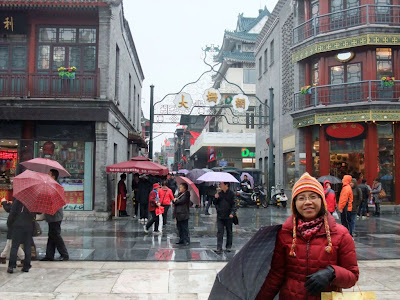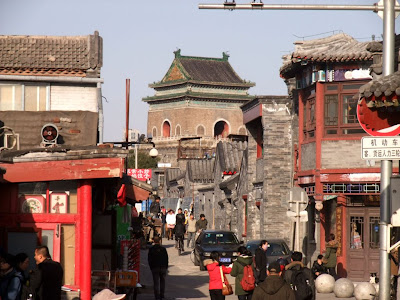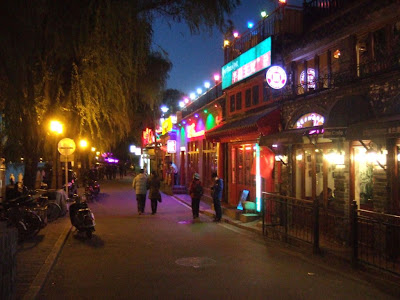

Hutongs are residential neighborhoods that formed the heart of old Beijing in contrast to court life and elite culture. They represent an important cultural element of Beijing, a city which has been a capital for six dynasties. It reflects the culture of grassroots Beijing people. Almost every Hutong has its anecdotes and some are even associated with historic events. Each Hutong has a name. Many are named after their location or land mark or business and few were given with an auspicious name. Some have had only one name since their establishment while others have had several throughout their history. Dashilan 大栅栏, located outside Qianmen Gate, should be the most ancient famous and distinctive old commercial street in Hutongs Beijing. It was originated in Yuan Dynasty (1271-1368) and built during Ming Dynasty (1368-1644) by locals who put wooden fences at both ends. The site was then developed and grew in prosperity in Qing Dynasty (1644-1911) and beyond. Since then, Dashilan 大栅栏 acquired its name. Although it has a history of more than 500 years, most of the ancient architecture are well preserved.


The ancient commercial street of this old city was also a center of entertainment, there were 5 opera theaters during prosperous time. Until now, you may enjoy an opera show at night in Deyunshe theater (德云社). Many famous old shops and time-honored brands in old Beijing still provide good products like Ruifu Xiang Silk Shop (瑞蚨祥), Nei Lian Sheng Shoe shop (内联升) and Maju Yuan Hat Shop which has been in the market for nearly 200 years.



Since 20th century, number of Beijing Hutongs has dropped dramatically as they are demolished to make way for new roads and buildings. Though Dashilan Hutong are not in good condition, some Hutongs have been designated as protected areas recently in an attempt to preserve the aspect of Chinese cultural history.




Qianmen Gate Dashilan 大栅栏 is famous for all kinds of stores with antique flavor. It attracts 160-200,000 people a day. To many people, it is a bustling attraction, a place to experience the relics of Beijing's historic wealth. Goubuli Steamed Bun Shop is one of the popular shops in the capital city mainly due to its legend saying that a person named Gouzi whose steamed bun were so delicious that too many customers waiting to eat his bun making him no time to response to people's greeting.



We visited Laoshe Teahouse in the rain. It is very famous in Beijing Capital City mainly due to the name Laoshe, who was a notable Chinese writer, a novelist and a dramatist. He was one of the most significant figures of 20th century Chinese literature. Tea House was one of his important novels besides The Rickshaw Boy which was published in 1936 and became America's best seller in 1945 after translated in English.



Laoshe Teahouse is grand and tradition in atmosphere. Tea served is fabulous especially its taste, so far it is the best one we ever tried before, and of course it costs us a fortune as well. We paid 80rmb and 60rmb for these two cups of tea only.


Experience a slice of Beijing's culture and follow the olden literates immersed in the moment to enjoying the tea with sweet little dimsam (desert).



Laoshe Teahouse is also popular for its night entertainment. There is package ticket for you to watch the performance of Beijing acrobatics, opera show, wood clapping and face-changing on the stage while enjoying a cup of good tea down at the platform. We did not manage to arrange the time for that, anyway, will try in our next trip to Beijing.




Bell Tower stands closely behind the Drum Tower at the north end of central axis of inner city in Beijing. Both towers dominated Beijing's ancient skyline.


Gulou which means Drum Tower was built in 1272 during the reign of Kublai Khan, originally constructed for musical reasons but later used to announce time and of course now it had turned into a tourist's attraction.



Bell and Drum Towers are the center of chronology during Yuan, Ming and Qing Dynasties, and they continue function as the official timepiece of China until 1924 when the last Emperor of Qing was forced to leave Forbidden City.



Dumpling and Zhajingmen noodles are some of the old Beijing delicacies and they taste great.


The fried rings with mixed beans soup is another local favorable dish but the taste is a bit too raw for us.


Yandai Xiejie 烟袋斜街 literally means skewed tobacco Pouch Street。 The street looks like a long stemmed pipe and it used to be a famous street for selling long stemmed pipes.



Though many of Beijing Hutongs had disappeared due to development but many of them still stand and a number of them have been designated protected areas.



The older neighborhoods survive today, offers a glimpse of life in the capital city as it had been for generations.




Shichahai (什刹海) is a famous scenic area in north west Beijing. It covers a large area of 363 acres including 3 lakes namely Front, Rear and West lake. Millions of people are attracted not only by its scenic beauty but also by its surrounding places of historic interest, and the remnants of old-style local residences, Hutongs and courtyards.



The history of Shichahai was traced back to as far as Jin Dynasty (1115-1234). It's prosperity was mainly because it was a terminal point of The Great Canal in Yuan Dynasty (1271-1368). In Ming Dynasty (1368-1644) when channels ceased to be as smooth as they used to be, it changed from a bustling hub into a place of leisure where people could stroll around and admire the vast scenery or enjoy the cool shade under the willow trees.



The attraction lies not only in its natural scenery but also in the historical value of its architecture.




The residences, Hutongs and courtyards become the greatest part of interest to many visitors.



Visiting Hutongs by pedicab has become a popular activity for most visitors abroad or from other parts of the continent.


Most famous site in Shichahai is Jin Si Tao which include 18 Hutongs and the area still keeps an actual layout of its origin.



Shichahai abounds with tourists and many of which tour the Hutongs in pedicabs.



In the vicinity of Shichahai there are many Hutongs are several hundred years old.



In last 200 years, there are many Government officers, celebrities, monks or nuns chose to build mansions and temples at the site. Some famous old buildings include the farmer residence of Song Qing Ling and Mei Lan Fang as well as Guan Hua Temple.



The Prince's mansion Gong Wang Fu is also one of the famous historical buildings.











Kaojirou 烤季肉 is a shop starting selling roast meat since 150 years ago. Another historical food stall is Bao Du Zhang. The shop has been offering tripe of sheep for 4 generations.






Shichahai at night.



A very good choice of dinner: The pan stewed yellow croakier and baby cabbage soup with rice.



A visit to Shiheyuan, a traditional courtyard residence where they have different chambers at 4 directions. North chamber always occupied by the main master while the west chamber and east chamber are for children and south for the servants.



Shiheyuan like this scheme normally belongs to commoners, merchants, artisans or laborers. They are smaller in scale and simpler in design and decoration. The Hutongs formed were narrower also.



The calligraphy of Maozhe-Dong, the great man of China.


The central courtyard and the entrance door. The main structure and gate of Shiheyuan always face south for better lighting and the Hutongs are running from east to west. Many small tiny lanes runs from north to south are convenient passages between main Hutong.



Nanluogu-Xiang located east to Houhai Lake in the northern side of Forbidden City, is one of the oldest Hutongs that you must not miss in Beijing. The central alleyway that runs from north to south is about 800 meters long and off the central lane, there are 16 Hutong branches.



Nanluogu-Xiang has a history of 800 years and was once a home to celebrities, officials, artists and well off merchants. It is considered as one of the best preserved historical areas of Beijing Downtown.


A metal model demonstrating traditional habitual way of barbecue meat inside this old Post Office of Qing Dynasty. Stamps are being sold from the post office for you to mail out as a souvenir, through the ancient metal letter box standing outside the structure.


The 800 meter long alleyway is filled with bars, cafes, restaurants, interesting artsy, galleries with crafts, souvenir and cute boutique shops.



With 20 restaurants and 40 shops scattering along, Nanluogu-Xiang has been fully restored to its former glory.



Nanluogu-Xiang, a perfect blend of the past and present, indeed is a hidden gem in the capital city of China.




Many tourists enjoy strolling down the place, starting at one end and browsing their way to the other end. It is one of the most chic and trendy place to hang out in the afternoon and evening.



Some of the innovative food stalls



History of Beijing Hutongs:
The word Hutong is a term of Mongolian origin which means town, first appeared during Yuan Dynasty. In Chinese, Hutongs are kind of narrow alleys formed by lines of traditional courtyard residences called Shiheyuan 四合院. Hutongs are formed when Shiheyuan joins from one to another and neighborhoods are formed when Hutongs are connected from one to each other. Citizens of higher social status in Ming Dynasty were permitted to live closer to the center of the circles, the inner and outer cities that surround the Forbidden City. Large Shiheyuan of these high ranking officials and wealthy merchants often feature beautifully carved and painted roof beams and pillars and landscaped gardens. The Hutongs they formed were orderly lined by spacious homes and walled gardens. Compare to these neat appearance of Hutongs, the new ones built in Qing Dynasty were with no apparent plan and were built haphazardly on the outskirts of the old city. Hutongs became worsen during years 1911-1948 when Beijing deteriorated with unstable society, fraught with civil wars and repeated foreign invasions. The single family owned and occupied Shiheyuan were sub-divided and shared by many households with addition tacked on, with any materials available, as and when needed. The 978 Hutongs as listed in Qing Dynasty's record swelled to 1330 by year 1949. After 1949, many Hutongs started to disappeared and replaced by wide boulevard and high rises. Many residents left the lanes where their family lived for generations for apartment buildings with modern amenities.




No comments:
Post a Comment